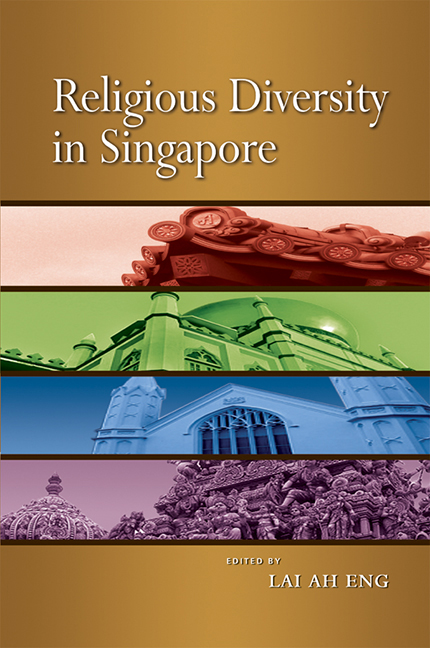Book contents
- Frontmatter
- Contents
- List of Figures and Tables
- List of Appendices
- FOREWORD
- PREFACE
- Acknowledgements
- The Contributors
- Abbreviations
- Glossary
- INTRODUCTION
- PART I The Landscape of Religious Diversity
- 1 Religious Influences and Impulses Impacting Singapore
- 2 Religious Trends and Issues in Singapore
- 3 Keeping God in Place: The Management of Religion in Singapore
- 4 Discourses on Islam in Southeast Asia and Their Impact on the Singapore Muslim Public
- 5 Global Christian Culture and the Antioch of Asia
- 6 “Religiously-inspired”, “India-derived” Movements in Singapore
- 7 Baha'is in Singapore: Patterns of Conversion
- 8 Diversities and Unities: Towards a Reformist Buddhism in Singapore
- 9 The Sathya Sai Baba Movement in Singapore: Its Service Mission and Philosophy of Communal Identity Construction
- 10 The Muslim Religious Elite of Singapore
- 11 The Evolution of the Sikh Identity in Singapore
- 12 Religious Processions: Urban Politics and Poetics
- PART II Religion in Schools and Among the Young
- PART III Religion in the Media
- PART IV Religious Organizations in Social Services
- PART V Interfaith Issues and Interaction
- Index
8 - Diversities and Unities: Towards a Reformist Buddhism in Singapore
from PART I - The Landscape of Religious Diversity
Published online by Cambridge University Press: 21 October 2015
- Frontmatter
- Contents
- List of Figures and Tables
- List of Appendices
- FOREWORD
- PREFACE
- Acknowledgements
- The Contributors
- Abbreviations
- Glossary
- INTRODUCTION
- PART I The Landscape of Religious Diversity
- 1 Religious Influences and Impulses Impacting Singapore
- 2 Religious Trends and Issues in Singapore
- 3 Keeping God in Place: The Management of Religion in Singapore
- 4 Discourses on Islam in Southeast Asia and Their Impact on the Singapore Muslim Public
- 5 Global Christian Culture and the Antioch of Asia
- 6 “Religiously-inspired”, “India-derived” Movements in Singapore
- 7 Baha'is in Singapore: Patterns of Conversion
- 8 Diversities and Unities: Towards a Reformist Buddhism in Singapore
- 9 The Sathya Sai Baba Movement in Singapore: Its Service Mission and Philosophy of Communal Identity Construction
- 10 The Muslim Religious Elite of Singapore
- 11 The Evolution of the Sikh Identity in Singapore
- 12 Religious Processions: Urban Politics and Poetics
- PART II Religion in Schools and Among the Young
- PART III Religion in the Media
- PART IV Religious Organizations in Social Services
- PART V Interfaith Issues and Interaction
- Index
Summary
INTRODUCTION: REINVENTING A SYNCRETIC BUDDHISM
Singapore is made up of originally migrant populations that arrived during the early nineteenth and twentieth centuries. A vast majority of the Chinese migrants were peasants who came from the two coastal provinces of Guangdong and Fujian in South China. When they arrived, they brought along their cultures and religion and reproduced them in a colonial environment, including knowledge of a syncretic Chinese religious belief system which was a composite mixture of Buddhism, Taoism and Chinese folk beliefs.
Scholars of Chinese syncretic religion refer to this form of syncretism in various terms. For example, Tan called it “Chinese religion” (Tan 1995, p. 139), while Elliot termed it “Shenism” (Elliot 1955). Wee noted that the majority of the Singaporean Chinese Buddhists were in fact practising Chinese religion with Buddhist elements (Wee 1976, pp. 155–88), while in my own work, Elliot's definition of Shenism is adopted here, as the Chinese continually termed their religious act as “bai shen”, literally “praying to the gods”. This syncretic system presents the Chinese cosmological worldview with a synthesis of Taoist and Buddhist metaphysical ideas, with Confucianism providing the moral base. It is therefore essential to explore the intersections of the Taoist, Buddhist, Confucianist and Shenist universes to understand how the early Chinese viewed their belief system.
These syncretic religious rituals continue to be practised by the older generation Chinese in Singapore. According to Watson, the Chinese were concerned with the ritual practices rather than the ideological purity of their religious practices (Watson 1988, p. 5). Religion was seen to serve an instrumental function rather than for expressive spiritual needs, although at times the two came hand-in-hand. The result of such practices was the emergence of various types of religious cults, some Buddhistic while others are Taoist and Shenist in nature. Thus, we see a proliferation of the cults of Guandi, Ancestors, Heaven, Heavenly Mother or Empress, Goddess of Mercy (Guanyin), Dabogong (Great Paternal Uncle) and others since the days of early immigration and which have continued into the present (Kuah-Pearce 2003, pp. 33–49).
- Type
- Chapter
- Information
- Religious Diversity in Singapore , pp. 195 - 214Publisher: ISEAS–Yusof Ishak InstitutePrint publication year: 2008



